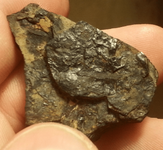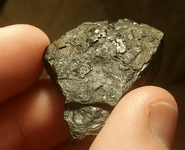Hello! Need some expert advice here on coal identification. I've been digging in an area that was once an old coal mining town, and I believe I've found some of the old coal from time to time. On the other hand, maybe it isn't coal, or maybe it isn't the kind of coal that was mined in the area and is instead some kind of import (e.g., maybe it is coal someone was using to heat a house later on). The problem is that I really don't know the first thing about coal. Here's what I can tell you about the specimens I've found:
1) They are black.
2) They are shiny on some places of the surface, but matte on others.
3) They are very lightweight.
4) They are rather smooth, and feel like a piece of melted plastic when you run your finger over the surface.
5) They are composed of several layers which will flake apart without much effort.
6) If you toss them in a fire, they will soon ignite in a small fireball, burning for several minutes before starting to look like all the other wood coals in the fire.
7) They sometimes appear to contain fossils on the surface of layers.
Here are a couple of pictures of one such example.


Based on my research, I believe that this stuff is coal. But I suppose there are possibly other flammable rocks out there besides coal.
Regardless, I'm in search of some type of coal below the grade of anthracite. Possibly bituminous, possibly sub-bituminous, but the historical records really aren't that clear about the type. Let me know if you can verify the identity of this stuff!
Thank you!
1) They are black.
2) They are shiny on some places of the surface, but matte on others.
3) They are very lightweight.
4) They are rather smooth, and feel like a piece of melted plastic when you run your finger over the surface.
5) They are composed of several layers which will flake apart without much effort.
6) If you toss them in a fire, they will soon ignite in a small fireball, burning for several minutes before starting to look like all the other wood coals in the fire.
7) They sometimes appear to contain fossils on the surface of layers.
Here are a couple of pictures of one such example.


Based on my research, I believe that this stuff is coal. But I suppose there are possibly other flammable rocks out there besides coal.
Regardless, I'm in search of some type of coal below the grade of anthracite. Possibly bituminous, possibly sub-bituminous, but the historical records really aren't that clear about the type. Let me know if you can verify the identity of this stuff!
Thank you!





